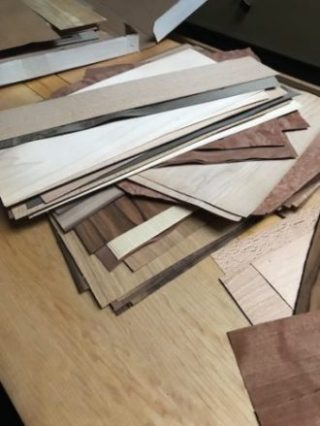I have an idea for a marquetry project. How do I go about getting it done? Sometimes, it is difficult to implement an idea once it appears. Yes, it is almost impossible to start. Whether it is putting pen to paper or coming around to the wood shop for atmosphere, my mind gets blocked. What or who is holding me back?
A deep search reveals a few things. It may be a simple case of having nothing to do or say for the moment. My response, then, is to accept that and get out of the shop and out of my head. There are other things I can do while I wait for inspiration to come to me.
Before stepping up to my wood bench, I always take a little time to get my mind right. It’s my personal pep rally. If I am fortunate, an interesting idea will land. I’ll catch it before it flies away and leaves me stranded.
The idea shows itself
After a while, an idea keeps returning, forcing me to face my fears and reality. It is something deep and powerful that I must do or say. It wants to stay. I think I’m not yet ready to accept it. So I quash it. In the back of my mind I wonder if the thought or idea might be unconventional (usually) or even life-affirming. The block, I know, is self-imposed. I realize that I am censuring myself.
Dark art of tradition
Frankly, trying to replace a rejected idea with another is draining. Rules and traditions dominate the decision-making process. It seems, on the surface, easy to let it be. But I am well aware of the torture fostered by tradition.
At this point, I’ve completely ignored the idea that I wanted in order to “comply”. But I’m still beating back fear of failure, ridicule, scorn, or judgment.
And that is the problem. In spite of the effort and resources used to complete the project, I don’t like it. Maybe it’s much too “according to the rules” – not at all like me.
But I want to like and enjoy what I do.
Shining the light
How do I get out of the box? Is there any obligation to stay in it and adhere to “traditional” art for someone else’s sake? The demand that things be done as they always have been done is increasingly disregarded. Why?
Tradition is wielded like a hammer. It’s a powerful weapon of enforcement by people, entities, and institutions that benefit from its use. And they don’t want you to participate in the enjoyment of those benefits in any way. They do need your fealty or loyalty, work, and dues which you must pay to feel “included”.
Most of us conform as a result of the intrinsic human need to belong. We want the lesser benefits – recognition, social status, and financial reward. It feels good, I admit. After we get them, however, we realize that the personal price to keep them is high. The tragic part is the fragility of membership. A small slip brings retribution and ostracization. That’s always on the tip of the tongue or the pen. And we fear being left out!
History provides testimony that unearned, eccentric, and unstable power chokes off the future – for a while. It attempts to suffocate innovation, change, and hope. History also shows that change was often fought for and won by women and men who flipped the switch, oxygenated their spaces, and took a collective deep breath. They asserted their natural right to be free to think, act, and choose.
As influence wanes, a desperate call, from the beneficiaries, to adhere to and restore the “old ways” gets louder.
Well, those old ways, like the past, cannot be restored.
Unbound
Old rules may be useful for seeding a concept or providing guidance. However, the “quacking ducks, elephants in the room, and wizards of oz” have to be recognized as the instruments of denial that they are.
Why would anyone adhere to rules, conventions, and traditions that are often used to judge and oppress them? They were created to do the most harm to the most humans. Blindly adhering to some of those traditions is a form of self-harm. Critically thinking about that is confounding and painful. We are not taught to really think. In many places on this planet, it is the same. It is not taught to us in our formative years. Even so, we can learn to do it at any age. Sadly for many, right is wrong, ignorance, and hopelessness is the accepted way of life.
The moment of reckoning – that healing of the hurt from oppression takes a while. However, once we become unafraid of change, we can heed the lessons, courageously move forward, and heal at the same time.

Opening that door
Making a personal portal or door in my woodworking space helps release the constraints and pressure of conventional thinking. Often it is done out of necessity. Most of the time it is to satisfy something beyond basic human needs. That is the basis for my creative process. I embrace my freedom and trust myself to create and invigorate the spaces in which I live and work.
My wood shop, where I work and think, is a place of healing and solace. It’s a small space but big enough for my thoughts and ideas to grow. I remember that everyday.
No one slaps me on the side of my head if I don’t follow the “rules”. No one hovers over me in my own shop. Contorting my brain to fit an incongruous idea or concept is not life-affirming. In fact, it is life-destroying.
Conventions made to rule humans and exclude them from any creative field must be challenged, modified, or ignored. These are the exclusive arenas that never were intended for me to enter.
But I have been here from the beginning.
I am in my shop, today, to implement an idea. So let’s invite it in and get on with the work.
A marquetry primer
The veneer hammers that I made in the last post will be drafted to play with a small marquetry idea. It is practice for a larger future project.
Veneering is the gluing of thin slices of fine or rare woods to a relatively inexpensive wood base. These become furniture parts – flat panels such as doors, tops, cabinet fronts and sides.
In marquetry, thin sheets of wood, metal, shell, and semiprecious materials, are cut into intricate patterns. The design is glued to the flat surfaces of furniture.
The ébéniste or marquetry specialist designs and draws the pattern. Then, the marquetry “puzzle ” is constructed and applied to the base with liquified hide glue.
Ebonist: a person who carves or trades in ebony or other decorative wood.
Ébéniste: ebony cabinetmaker
+
Ebonics: ebony phonics
=
la Éboniste: Me
I like to think of these techniques and terms as variations of a theme.
Yes, I went there.
Shirley J 🖤
la Éboniste
•:•
Next time: A tiny marquetry project.

